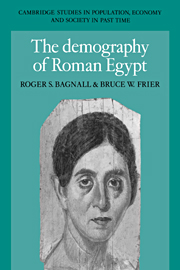Book contents
- Frontmatter
- Contents
- List of figures
- List of tables
- Foreword
- Preface
- A note on references and abbreviations
- 1 The census returns
- 2 The census returns as demographic evidence
- 3 Households
- 4 Female life expectancy
- 5 Male life expectancy and the sex ratio
- 6 Marriage
- 7 Fertility
- 8 Migration
- 9 Conclusion
- Catalogue of census declarations
- Catalogue of census declarations Supplement
- Appendixes
- Bibliography
- Index
- Cambridge Studies in Population, Economy and Society in Past Time
6 - Marriage
Published online by Cambridge University Press: 06 January 2010
- Frontmatter
- Contents
- List of figures
- List of tables
- Foreword
- Preface
- A note on references and abbreviations
- 1 The census returns
- 2 The census returns as demographic evidence
- 3 Households
- 4 Female life expectancy
- 5 Male life expectancy and the sex ratio
- 6 Marriage
- 7 Fertility
- 8 Migration
- 9 Conclusion
- Catalogue of census declarations
- Catalogue of census declarations Supplement
- Appendixes
- Bibliography
- Index
- Cambridge Studies in Population, Economy and Society in Past Time
Summary
Marriage in Roman Egypt differed arrestingly from its modern equivalent. Although marriage was a legal state with consequences especially for the legitimacy of children, the government regulated it lightly. For the most part, among native Egyptians, Greeks, and Roman citizens alike, marriage was a private matter between the spouses (as well as, in many cases, their families); both formation of marriage and its termination through divorce or otherwise usually occurred without the government intervening or even being notified. In discussing the census returns, it is important to bear in mind the relative informality of marriage institutions in Roman Egypt.
For demographers, the sequence of marriage, separation or widowhood, and remarriage (collectively referred to as nuptiality) is important less in itself than for its relationship to the age at which regular sexual relations normally begin and end for women, as well as to the forming and dissolution of families and households.
Age at first marriage
The census returns do not declare the ages at which spouses were married. However, this question can be approached indirectly. Table B summarizes the current marital status of 206 free females and 218 free males whose reported age is 10 or older; data are taken only from returns in which the principal resident family is complete or nearly complete, so that marital status is likely to be determinable. Persons are counted as married if the census return attests a current spouse, regardless whether that spouse is known to be co-resident; and as formerly married if described as such, or if there are other signs of prior marriage, especially the presence in the household of apparently legitimate children.
- Type
- Chapter
- Information
- The Demography of Roman Egypt , pp. 111 - 134Publisher: Cambridge University PressPrint publication year: 1994



